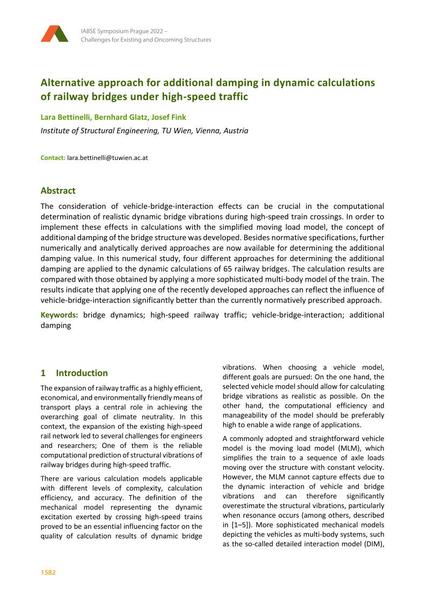Alternative approach for additional damping in dynamic calculations of railway bridges under high-speed traffic

|
|
|||||||||||
Bibliographic Details
| Author(s): |
Lara Bettinelli
(Institute of Structural Engineering, TU Wien, Vienna, Austria)
Bernhard Glatz (Institute of Structural Engineering, TU Wien, Vienna, Austria) Josef Fink (Institute of Structural Engineering, TU Wien, Vienna, Austria) |
||||
|---|---|---|---|---|---|
| Medium: | conference paper | ||||
| Language(s): | English | ||||
| Conference: | IABSE Symposium: Challenges for Existing and Oncoming Structures, Prague, Czech Republic, 25-27 May 2022 | ||||
| Published in: | IABSE Symposium Prague 2022 | ||||
|
|||||
| Page(s): | 1582-1589 | ||||
| Total no. of pages: | 8 | ||||
| DOI: | 10.2749/prague.2022.1582 | ||||
| Abstract: |
The consideration of vehicle-bridge-interaction effects can be crucial in the computational determination of realistic dynamic bridge vibrations during high-speed train crossings. In order to implement these effects in calculations with the simplified moving load model, the concept of additional damping of the bridge structure was developed. Besides normative specifications, further numerically and analytically derived approaches are now available for determining the additional damping value. In this numerical study, four different approaches for determining the additional damping are applied to the dynamic calculations of 65 railway bridges. The calculation results are compared with those obtained by applying a more sophisticated multi-body model of the train. The results indicate that applying one of the recently developed approaches can reflect the influence of vehicle-bridge-interaction significantly better than the currently normatively prescribed approach. |
||||
| Keywords: |
bridge dynamics Vehicle-Bridge-Interaction High-speed railway traffic additional damping
|
||||
| Copyright: | © 2022 International Association for Bridge and Structural Engineering (IABSE) | ||||
| License: | This creative work is copyrighted material and may not be used without explicit approval by the author and/or copyright owner. |
||||

